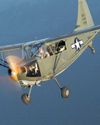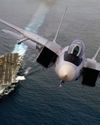Poging GOUD - Vrij
HELLCAT VERSUS CORSAIR
Flight Journal
|Annual 2020
GRUMMAN TEST PILOT FLIES THE COMPETITION

Whenever Navy and Marine Corps aviators who flew and fought in propeller-driven fighters gather, there is always the argument about which was the better airplane: the “bent-wing bastard,” as we lovingly dubbed the Chance Vought F4U-lD Corsair, or the Grumman Hellcat? I am sure that many beers have been consumed and many loud, emotional discussions have taken place on this subject.
In the desperate climate of WW II, the Navy decided that the easiest, quickest, and least costly way to tweak the utmost performance out of its fighter planes would be to let rival manufacturers test the latest versions of one another’s products. So, in the summer of 1943, the Navy delivered into Grumman hands the newest Corsair (F4UlD Buno 17781). I was privileged to be the project engineering test pilot for the F6F-3 Hellcat at the time.

Grumman’s specific orders from the Navy were to improve the Hellcat’s speed by 20 knots and put better ailerons on it so that it would compare favorably with the incomparable Corsair. We were motivated by the strongly implied “or else” in between the lines.
We were also pleased to learn that we had not been singled out for harassment of our sterling product when we heard that Chance Vought, our friendly competitor from the other side of Long Island Sound, was sent an F6F-3 Hellcat and ordered to improve the Corsair’s visibility, cockpit internal layout, and stall characteristics and to redesign the landing-gear Oleos (the Corsair bounced badly on landing). In other words, make the Corsair fly as well as its friendly competitor, the Grumman Hellcat.
Dit verhaal komt uit de Annual 2020-editie van Flight Journal.
Abonneer u op Magzter GOLD voor toegang tot duizenden zorgvuldig samengestelde premiumverhalen en meer dan 9000 tijdschriften en kranten.
Bent u al abonnee? Aanmelden
MEER VERHALEN VAN Flight Journal

Flight Journal
ELLIPTICAL ELEGANCE
Flying and evaluating the Seafire Mark III
4 mins
November - December 2025

Flight Journal
IRON DOG
Fighting the Pacific and the P-39 at the same time
14 mins
November - December 2025

Flight Journal
Fighter Pilots: A Warrior Clan
TAKE A HARD LOOK at the two young men in these photos. Do they look as if they were bent on killing one another? On the left we have a young, unknown enlisted Japanese pilot standing in front of a Nakajima Ki-27 \"Nate,\" one of Japan's earliest monoplanes that led to the much vaunted Zero.
3 mins
November - December 2025

Flight Journal
KEN WALSH THE FIRST CORSAIR ACE
Medal of Honor pilot's combat adventures
12 mins
November - December 2025

Flight Journal
Big Chief's Little Chief
Thunderbolt action with the Wolf Pack
11 mins
November - December 2025

Flight Journal
ENEMY PILOTS SPEAK Voices from the other side
All too often American students of air warfare forget that enemy aircraftwhether Messerschmitts or MiGs-were flown by human beings with the same motivations and traits as Allied airmen. More often than not, the only difference between friend and foe was the paint on the airplane and where they landed. Therefore, we've assembled a variety of accounts from WW II Axis fighter pilots, men who were more than simply targets.
11 mins
November - December 2025

Flight Journal
FLYING THE FW 190
A legend gets checked out in the Butcher Bird
15 mins
November - December 2025

Flight Journal
DOUBLE-THEATER ACE
The fearless missions of legendary fighter pilot Col. John D. Landers
12 mins
November - December 2025

Flight Journal
WARBUG IN THE PACIFIC
Surviving combat in a Stinson OY-1/L-5
10 mins
September - October 2025

Flight Journal
WINGS OF THE FLEET
Celebrating the U.S. Navy's 250-year legacy
9 mins
September - October 2025
Translate
Change font size

